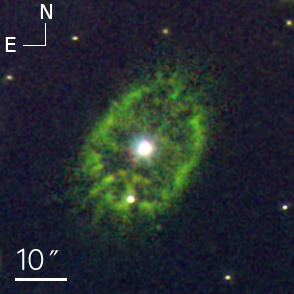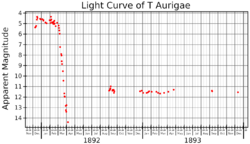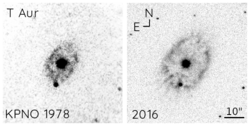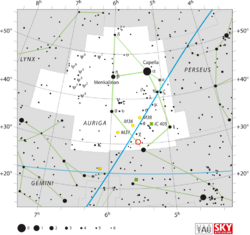Astronomy:T Aurigae
 RGB composite color image of the shell surrounding the nova T Aurigae, made from three narrow band images: Blue = 4800Å, green = Hα at 6563 Å and red = [NII] at 6583 Å. From Santamaria et al. 2020[1] | |
| Observation data Epoch J2000.0 Equinox (celestial coordinates) | |
|---|---|
| Constellation | Auriga |
| Right ascension | 05h 31m 59.118s[2] |
| Declination | +30° 26′ 45.03″[2] |
| Apparent magnitude (V) | 4.5Max. 15Min. |
| Astrometry | |
| Distance | 880+46 −35[3] pc |
| Characteristics | |
| Variable type | Classical Nova, Eclipsing Binary |
| Other designations | |
Nova Aur 1891, GCRV 56251, Lan 652, SBC9 326, BD+30° 923a, HD 36294, CDS 507, HR 1841, AAVSO 0525+30, Gaia DR2 3446266197646225536 | |
| Database references | |
| SIMBAD | data |
T Aurigae (or Nova Aurigae 1891) was a nova, which lit up in the constellation Auriga in 1891. Thomas David Anderson, an amateur astronomer in Edinburgh, reported that he was "almost certain" he saw the nova at 02:00 UT on 24 January 1892, when it was slightly brighter than χ Aurigae (apparent magnitude 4.74). He mistook the star for 26 Aurigae, although he noted to himself that it seemed brighter than he remembered it being. He saw it twice more during the following week. On 31 January 1892 he realized his mistake, and wrote a note to Ralph Copeland (the Astronomer Royal of Scotland) reporting his discovery.[4] Professor Copeland immediately reported the discovery via telegram to William Huggins, who made the first spectroscopic observations of T Aurigae on 2 February 1892, when the star was a magnitude 4.5 object.[5] T Aurigae was the first nova to be observed spectroscopically.[6]

Strope and Schaefer report that the peak brightness of T Aurigae was magnitude 4.5,.[8] Pre-discovery images on photographic plates allowed the a light curve beginning in late 1891 to be constructed.[7] AAVSO data shows that T Aurigae's quiescent magnitude is 15.3.
In 1958 observations of the stars forming T Aurigae with the Crossley telescope showed that it is an eclipsing binary, with a period of 4.9 hours, and an eclipse depth of 0.18 magnitudes.[9] T Aurigae was the third nova that was discovered to be a short-period eclipsing binary, and that discovery led to increased speculation that the nova phenomenon was connected to close binary star pairs.[10] Today it is believed that all novae are binary stars, with a "donor" star orbiting a white dwarf. The stars are so close to each other that matter is transferred from the donor star to the white dwarf.
Nebula

T Aurigae is surrounded by an emission nebula (shell) which is roughly elliptical (25 arc seconds by 19 arc seconds in size) and resembles a planetary nebula. Its 3-dimensional shape is similar to a prolate ellipsoid, but it has a central waist, making it shaped somewhat like a peanut.[11] Santamaria et al. obtained images of this shell from 2016 through 2019 and by comparing those images to archival images dating back to 1956, they were able to determine that the shell is expanding at about 0.01 arc seconds per year, corresponding to an expansion velocity of about 350 km/sec.[1]
References
- ↑ Jump up to: 1.0 1.1 1.2 Santamaria, E.; Guerrero, M.A.; Ramos-Larios, G.; Toala, J.A.; Sabin, L.; Rubio, G.; Quino-Mendoza, J.A. (March 2020). "Angular Expansion of Nova Shells". The Astrophysical Journal 892 (1): 60. doi:10.3847/1538-4357/ab76c5. Bibcode: 2020ApJ...892...60S.
- ↑ Jump up to: 2.0 2.1 Brown, A. G. A. (August 2018). "Gaia Data Release 2: Summary of the contents and survey properties". Astronomy & Astrophysics 616: A1. doi:10.1051/0004-6361/201833051. Bibcode: 2018A&A...616A...1G. Gaia DR2 record for this source at VizieR.
- ↑ Schaefer, Bradley E. (2018). "The distances to Novae as seen by Gaia". Monthly Notices of the Royal Astronomical Society 481 (3): 3033–3051. doi:10.1093/mnras/sty2388. Bibcode: 2018MNRAS.481.3033S.
- ↑ Copeland, Ralph; Becker, L. (August 1892). "On the new star in the constellation Auriga". Astronomy and Astro-Physics 11: 593–602. Bibcode: 1892AstAp..11..593C. https://ui.adsabs.harvard.edu/abs/1892AstAp..11..593C. Retrieved 11 December 2020.
- ↑ Huggins, William; Huggins, Margaret Lindsay (August 1892). "On Nova Aurigae". Astronomy and Astro-Physics 11: 571–581. Bibcode: 1892AstAp..11..571H. https://ui.adsabs.harvard.edu/abs/1892AstAp..11..571H. Retrieved 11 December 2020.
- ↑ Mclaughlin, Dean B. (October 1950). "Problems in the Spectra of Novae". Publications of the Astronomical Society of the Pacific 62 (367): 185. doi:10.1086/126273. Bibcode: 1950PASP...62..185M.
- ↑ Jump up to: 7.0 7.1 Shapley, Harlow (January 1933). "The photographic light curves of 11 novae". Annals of the Astronomical Observatory of Harvard College 84 (5): 121–155. Bibcode: 1933AnHar..84..121S. https://ui.adsabs.harvard.edu/abs/1933AnHar..84..121S. Retrieved 23 January 2021.
- ↑ Strope, Richard J. (July 2010). "Catalog of 93 Nova Light Curves: Classification and Properties". The Astronomical Journal 140 (1): 34–62. doi:10.1088/0004-6256/140/1/34. Bibcode: 2010AJ....140...34S.
- ↑ Walker, Merle F. (January 1962). "Nova T Aurigae 1891: a New Short-Period Eclipsing Binary". Information Bulletin on Variable Stars 2: 1. Bibcode: 1962IBVS....2....1W. https://ui.adsabs.harvard.edu/abs/1962IBVS....2....1W. Retrieved 11 December 2020.
- ↑ Walker, Merle F. (August 1963). "Nova T Aurigae 1891: a New Short-Period Eclipsing Binary". Astrophysical Journal 138: 313. doi:10.1086/147646. Bibcode: 1963ApJ...138..313W. https://ui.adsabs.harvard.edu/abs/1963ApJ...138..313W. Retrieved 11 December 2020.
- ↑ Santamaría, E.; Guerrero, M. A.; Zavala, S.; Ramos-Larios, G.; Toalá, J. A.; Sabin, L. (2022). "Spatio-kinematic models of five nova remnants: Correlations between nova shell axial ratio, expansion velocity, and speed class". Monthly Notices of the Royal Astronomical Society 512 (2): 2003–2013. doi:10.1093/mnras/stac563. Bibcode: 2022MNRAS.512.2003S.
External links
 |


